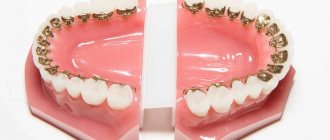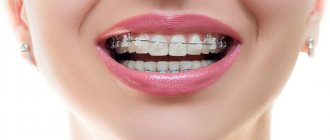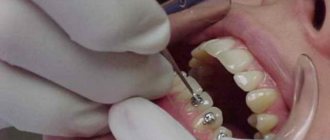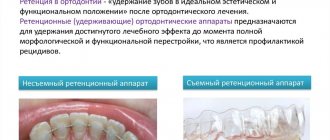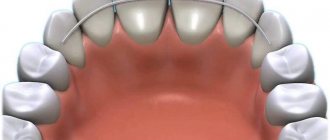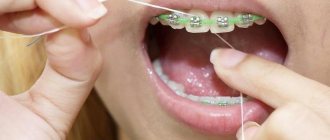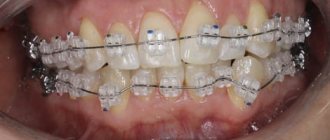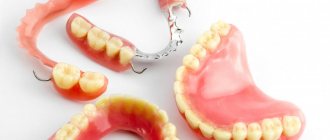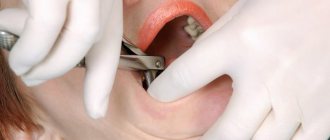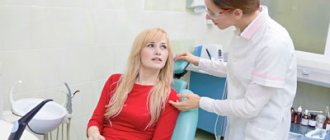Bite problems in children | Self-ligating and ligature systems | Types of self-ligating structures | Material for making braces | Cost of treatment
Parents often ask which braces are best for a teenager, what is the time frame and cost of correcting the bite. The answer to these questions depends on the age of the child and the results of a comprehensive examination: identifying individual characteristics of the development and growth of the facial skeleton, the presence of erupted teeth and tooth germs. During the primary occlusion period, braces are not installed. Orthodontic appliances begin to be worn at the age of 8-9 years: from the moment the upper and lower permanent incisors erupt. For young patients, braces are not fixed on all teeth, but only on four erupted incisors and two permanent molars.
The material was verified by Anna Rimkevich, senior product manager at Ormco Russia.
For children from the age of 12, from the moment of eruption of permanent teeth, the structure is installed on all teeth, just like in adult patients. The latter have no age restrictions on orthodontic treatment. The decision of which braces to place on a patient in adulthood depends on the complexity of the clinical case, the characteristics of the profession, aesthetic requirements and budget.
In the period from 12 to 18 years, the development of the dental system is most active. At this age, adolescents are strongly recommended to be monitored by an orthodontist. If it is necessary to correct the bite, treatment will proceed faster than in adults: bone tissue grows, teeth move easier, the forces of the young body are aimed at growth and formation of the facial skeleton. Early correction of a child’s bite allows one to avoid more complex and expensive treatment in adulthood.
teens with Damon Clear braces
Until what age does a person’s jaw grow? The formation of the jaws and facial bones ends by the age of 25. Until this age, the retention period, stabilization of treatment results, will be twice as long as the period of wearing the braces. Thus, when treated with ligature structures (from 2 to 3.5 years), the retention period will be 4 to 7 years. When correcting the bite using devices without ligatures (from 1 to 2.5 years), the retainer is fixed for 2 to 5 years. Patients over 25 years of age wear a retainer indefinitely.
girl with Damon Q
Prerequisites for bite problems in children
A visit to an orthodontist is a mandatory stage of medical examination for children and adolescents. The growth of the dental system is determined by various parameters: hereditary factors, environmental features of the region, bad habits of the child and psychological disorders.
Bad habits in children cause abnormalities in the growth and development of the facial skeleton and teeth. Prolonged thumb or pacifier sucking and insertion of the tongue between the teeth creates an open bite. Sleeping with your hand under your cheek causes misalignment of the jaw and teeth and causes the development of a crossbite. The infantile type of swallowing forms a distal bite. In such situations, it makes sense for parents to contact a child psychologist. An orthodontist corrects dental anomalies, but does not treat neurological and psychological disorders. After completing the psychological preparation of the child, parents and the doctor will have to choose a bite correction system.
What is dangerous to save on?
Savings are not always justified - the doctor’s unprofessionalism or the manufacturer’s cheap “no-name” orthodontic design can only aggravate the situation. What you shouldn't save on:
- On the devices themselves. Ask your orthodontist how much inexpensive braces cost, but at the same time compare the treatment time. For example, self-ligators can reduce wear time by a third, which will also reduce costs.
- At the doctor. If you want to reduce expenses, choose not only a clinic, but also a doctor. The professionalism of an orthodontist is not always determined by the city of residence.
- On care products. To properly care for the devices, immediately after installation, purchase a minimum set of care products. If this is not done, the risk of caries increases, and you will have to spend extra money on its treatment.
You can even find a clinic where braces can be installed inexpensively, even in Moscow. On your first visit, ask about discounts and promotions, discuss the scope of treatment, and ask to choose a budget design option taking into account individual indications.
Which bracket system is better: self-ligating and ligature designs
Bite correction systems differ in the method of fixing the archwire in the bracket groove. The classic option is ligature constructions. The arch is tightly fixed to each bracket with elastic or metal ligatures. The design is suitable for the treatment of anomalies of varying complexity. It is necessary to visit a doctor once a month to replace the archwires.
Orthos ligature braces
Self-ligating structures do not have elastic and wire elements fixing the arch in the bracket groove. Friction in the system is minimal. Arc sliding occurs under the influence of weak forces. Non-ligation structures do not require monthly visits to the doctor: it is enough to carry out activation once every 2-3 months.
self-ligating Damon Q2
According to the results of research by Khalid S. Hassan from the University of Ed-Dammam, Saudi Arabia, it was revealed that the microbial flora in the oral cavity when using self-ligating systems was lower than when treated with ligature structures. 22 patients participated in the study. In each case, two ligation systems were fixed in the oral cavity: ligature structures were installed on one side, and devices without ligatures were installed on the other. The use of ligature systems caused microbial colonization and increased the activity of the enzyme aspartate aminotransferase. Treatment with self-ligating braces turned out to be a more preferable method of occlusion correction from the point of view of preventing disorders in periodontal tissues.
What are the best braces for a child? Each clinical case requires an individual approach from the orthodontist. Only a doctor, based on the diagnosis and structural features of the young patient’s dental system, offers the most suitable options. As a rule, the issue of aesthetic preferences in children is not as acute as in adults. Teenagers often choose ligature or non-ligature metal systems. A wide variety of elastic ligatures allows you to express the individuality or mood of the child, and the visibility of the design has ceased to be a criterion for choosing a system. Teenagers wear devices with multi-colored elastic elements and do not experience discomfort.
non-ligature Damon 3MX metal
When treating children with braces, it is important for parents to pay attention to teaching the child oral hygiene and motivate them to follow all the orthodontist’s recommendations. Some teenagers, despite the instructions of their parents, pay insufficient attention to hygiene procedures. In this case, installing a non-ligature brace system for a child will be a more preferable option.
In what cases are braces placed?
The very essence of such treatment is the forced alignment of the dentition - this is the first thing that those who doubt the need to install them need to know about braces. Only these systems guarantee a visual effect within 10–12 months and can work even in complex cases of twisted or crooked teeth in adults.
In what cases are braces placed? Common indications for installation are:
- broken bite;
- facial asymmetry;
- presence of tooth gaps;
- crooked or twisted teeth;
- previous jaw injuries or other pathologies that provoked temporomandibular anomalies (crunching and characteristic discomfort may be present when chewing);
- unevenness of the dentition - protruding or recessed individual teeth.
There are different types of braces for children and adults. Their choice is always a joint work of the treating orthodontist and the patient.
Whichever option you choose, our specialists will conduct a detailed consultation taking into account the goals and individual priorities of each patient. Depending on which teeth the braces are placed on (type of malocclusion), we will help you choose the best option, prepare you for the procedures, and carry out all installation work without discomfort, pain, or fear.
Active and passive self-ligation
Self-ligation can be passive or active. With the active type of fixation, the bracket clip applies pressure and moves the archwire towards the base of the slot. The orthodontic arch, in turn, puts pressure on the clip. In the case of passive self-ligation, the cover fixes the archwire in the slot without exerting pressure on it. When closed, the bracket turns into a buccal tube: the static cover becomes the fourth wall of the groove, the arch moves freely and is not subject to force. Example: Damon Q.
Damon Q with orthodontic arch
Which braces are best for adults and pediatric patients? American orthodontist Vourdouris JC compared the frictional force of the arch in the bracket groove when using passive and active non-ligature structures. According to a study published in the American J. of Orthodontics & Dentofacial orthopedics, active systems operate with a high friction force of 31.0 g, while passive designs have a low friction force of 0.1 to 0.18 g.
The data obtained scientifically prove that passive self-ligating systems are able to interact with archwires throughout treatment without loss of force and provide a new standard of low friction when moving teeth. American scientists Thorstenson GA and Kusy supplemented the results of the study. Experts have found that when using the Damon System passive self-ligating system, there is significantly lower frictional resistance in dry and wet environments compared to active structures.
Studies conducted by orthodontists indicate the benefits of treatment with passive self-ligating braces.
Vestibular and lingual apparatus
Orthodontists install braces in the oral cavity in two ways: on the vestibular (visible) and lingual (in contact with the tongue) side of the dentition. With the lingual type of fixation, aesthetic indicators are higher, but the period of adaptation to internal braces is more difficult. Patients with lingual devices do not experience psychological discomfort: the devices are almost invisible to others. The cost of invisible structures is higher compared to traditional vestibular systems.
lingual braces STb
Final table comparison of types of structures
| Type of design | Peculiarities | Price |
| Metal | Easy installation. Minimum cost. High efficiency. Noticeable. | The most affordable. |
| Ceramic | Matched to the color of the teeth. Unnoticeable. Durable. Effective due to good adhesion. | Lower than sapphire, lingual, non-ligated, but higher than metal ones. |
| Sapphire | Transparent. Almost invisible. Do not cause allergies. Durable. Suitable for snow-white teeth. | Higher than metal ones, not much higher than ceramics. |
| Lingual | Completely invisible. Effective treatment. Longer addiction. | Premium class |
| Self-ligating | Comfortable to wear. Do not require frequent visits to the doctor. Aesthetic. Can be made from different materials. Speed up treatment. | Premium class |
Material of manufacture
In terms of material, there are braces made of metal, ceramic, plastic and combined models. The peculiarities of the manufacturing material, the complexity of the clinical case, aesthetic requirements and financial capabilities allow the doctor and the patient to jointly decide which bracket system is better. There are no universal recommendations.
Ligature systems are made from a metal alloy (Orthos, Mini Diamond) and transparent artificially grown sapphire (aesthetic Inspire ICE). Aesthetic ligature braces are superior in size to metal structures. The disadvantage is more complex activation and an increased period of patient adaptation to foreign structures.
aesthetic sapphire Inspire ICE
Non-ligature structures are made of metal (Damon Q, Damon 3MX) and especially durable ceramics (Damon Clear 2). The adaptation period is easier than when installing devices with ligatures. Treatment with Damon systems is reduced by an average of 7 months compared to treatment with ligature braces.
teens with Damon Q braces
If psychological comfort or the characteristics of an adult patient’s profession require an inconspicuous system, it is advisable to choose Inspire ICE sapphire braces or Damon Clear 2 ceramic braces. For a child, sapphire and ceramic structures are not always a good choice due to increased fragility: a teenager can accidentally damage the elements of the system as a result injury or poor diet.
transparent Inspire ICE on typodont
Is there a tax deduction for treatment with braces?
Wearing braces is a type of dental treatment and is subject to tax deduction. The cost of the devices themselves is not taken into account; the amount to which the deduction applies only includes:
- tooth extraction, caries treatment at the preparation stage and at the end;
- installation of a bracket system and additional elements;
- activation, removal of braces;
- professional teeth cleaning.
A tax deduction can be obtained if the patient has an official income from which he pays personal income tax. Compensation is due for your own treatment, as well as for your spouse, minor children or parents. You can use the deduction only within 3 years after treatment.
When calculating the deduction, the maximum amount is 120,000 rubles. From it the patient will be able to return 13% - up to 15,600 rubles. This amount can be returned every year - if braces are worn for more than a year, you can receive compensation for the entire period of treatment.
A deduction is due if the clinic where you got braces has a state license. This applies to both public and private organizations. When you find a clinic where you can get braces inexpensively, even before concluding a contract, inquire about the possibility of obtaining a tax deduction.
